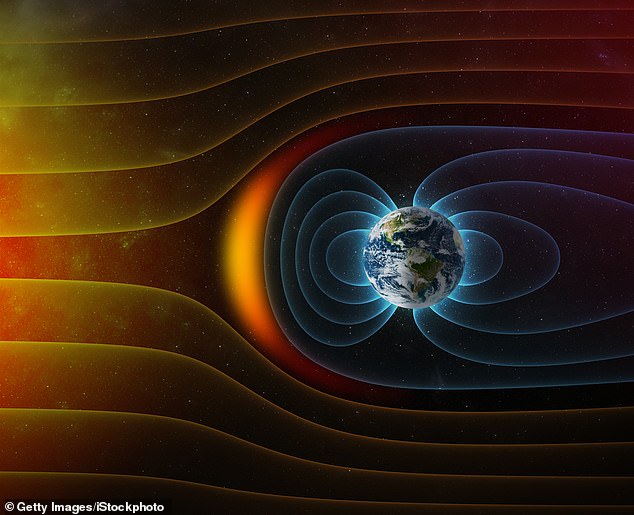Human couples could give birth to ALIEN babies as scientists work to pioneer sex in space – but gravity and radiation pose serious risks
>
No human has ever been born in space, but Dutch biotech startup Spaceborn United aims to change that.
Commercial spaceflight is already a reality, and although companies like SpaceX, Blue Origin, and Virgin Galactic have yet to fly passengers to the Moon or Mars, some visionary scientists believe it’s only a matter of time before humans become a space-faring species. .
Egbert Edelbrock, CEO of Spaceborn United, is one of those believers.
If humanity really wants to reach the stars, he says, we’ll need to find a way to reproduce there.
Passengers kiss on a flight that simulates weightlessness in space. Intimacy in zero gravity is just one of the challenges of extraterrestrial reproduction
His company’s near-term goal is to test whether it is possible to create laboratory rodents, give birth in space, and then live to give birth to healthy babies.
The ultimate goal of this research is to support human pregnancy and birth in space, a step Edelbrock says is essential if people want to live off Earth.
“Humanity needs a backup plan,” he said. MIT Technology Review. “If you want to be a sustainable organism, you want to be a multi-planetary organism.”
Spaceborn technology is central to this plan.
The company’s “space embryo incubator” is a disc-shaped device designed to contain male and female sex cells — sperm and eggs — and fuse them in low Earth orbit. The entire contraption is about the size of a shoe box.
After 5 to 6 days of development, the developing embryo will be cryogenically frozen and returned to Earth, where it will be examined to determine whether it can be implanted in a surrogate mother and carried to term, according to company policy. Media materials.
Freezing embryos is intended to help protect them during the traumatic event of reentering Earth’s atmosphere, Edelbrock says. He told AFP. “It’s a lot of shaking, a lot of oscillations, a lot of gravitational forces.” You don’t want to expose fetuses to this.
After issues with Spaceborn’s spaceflight partner delayed the first test this year, the device is scheduled to ascend to low Earth orbit in November 2024.
After this experiment, Spaceborn has plans to test fertilized human embryos under artificial gravity and then under microgravity conditions.
Reproduction is one of the most important functions of life on Earth, but what about life in space?

The combination of low gravity and high radiation would lead to unknown effects on developing human fetuses. Spaceborn is first exploring these effects in laboratory animals
The lack of gravity is one of the primary obstacles to extraterrestrial human reproduction. Without gravity holding two people’s bodies together, sex would be very difficult.
After fertilization, it is not clear how lack of gravity will affect fetal growth.

Humans will need to find a way to reproduce in space, says Egbert Edelbrock, CEO of Spaceborn United
some Research indicates A low-gravity environment can change how embryonic stem cells divide, how they differentiate into different cell types, and how they defend against DNA damage.
But all of these studies were conducted on dishes of cells grown in the laboratory, and it is not clear how the results will translate to the cells of a living animal or person.
Radiation is another major issue. Outside Earth’s magnetosphere, galactic cosmic radiation (GCR) would bombard a spacecraft and its occupants, potentially promoting DNA mutations and cancer.
For an embryo whose cells are dividing rapidly, this type of intervention could be disastrous.
In low Earth orbit, such as aboard the International Space Station, the Earth’s magnetosphere extends far beyond the planet’s surface to protect astronauts from the harmful effects of GCR.

Earth’s magnetosphere protects us from galactic cosmic radiation (GCR), but on a trip to Mars, astronauts will be bombarded by these space rays. Its effects on the developing fetus are unknown
But outside the magnetosphere, such as on the way to Mars, travelers will be bombarded with GCR.
Radiation exposure, especially for women in their mid- to late 30s, can cause this A significant increase Risk of developing certain types of cancer.
The effects of space radiation on astronauts’ central nervous systems appear to be tolerable, according to A Stady From this year exposure is designed over 30 days. But the mission to Mars is likely to last several years.
In promising news, mouse sperm has been preserved on the International Space Station Just as viable Such as those stored on Earth, according to a study published in 2021.
Spaceborn’s plans for experiments on human embryos are still years away, and even their experiments on mice have yet to get off the ground.
But with space tourism in full swing, it may only be a matter of time before a human couple tries to get pregnant in space.
(Tags for translation)dailymail
